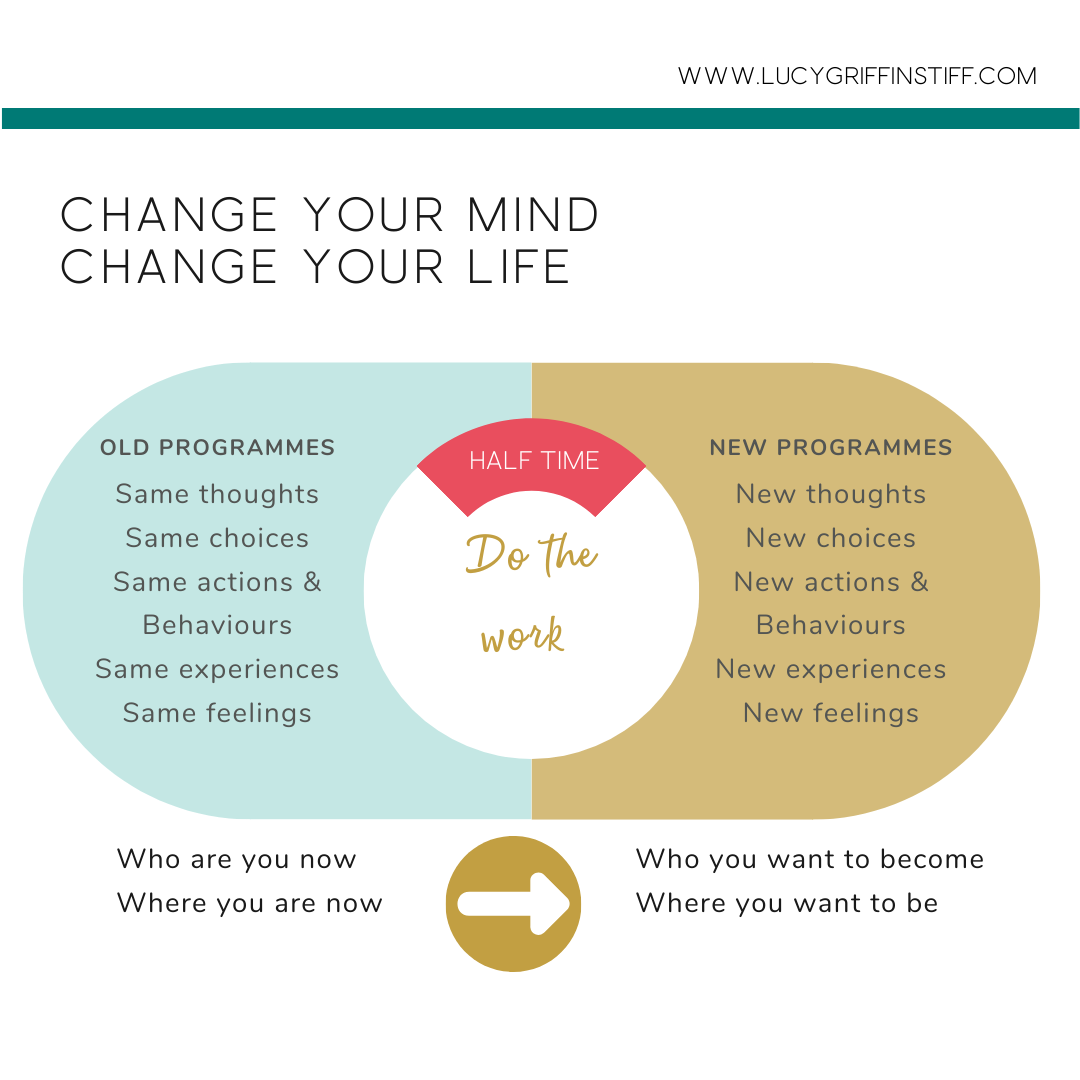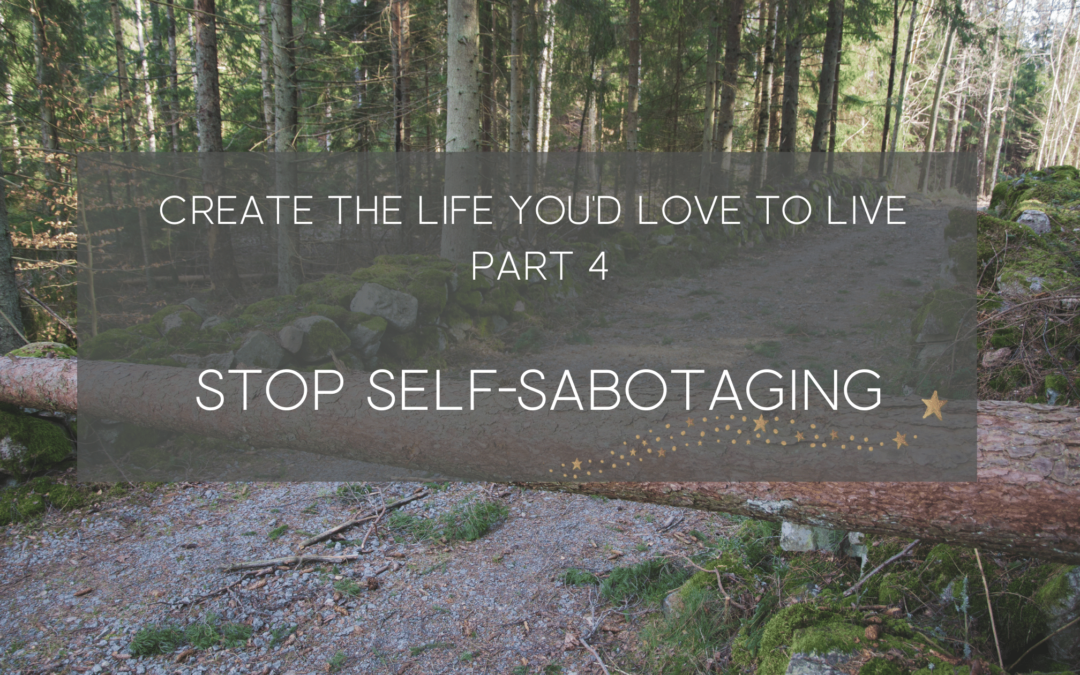Are you Self-Sabotaging your life?
We can have the best of intentions (and indeed setting intentions is an important part of creating the life you’d love to live), however even with the best of intentions we can stop ourselves from meeting them because we get in our own way.
It seems crazy to set our sights on something that we say we want to only make choices that stop it happening – but we all do this in some form or another!
Self-sabotage is a real thing. Nearly all of us will have some form of self-sabotaging behaviour.
It’s essentially born out of the fact the brain is programmed to keep us safe. To move away from fear and threat and towards comfort or reward.
Self-sabotage can show up in different parts of your life whether it’s work or career, relationships, or health, we have learned unhelpful limiting beliefs that are often the root cause of your self-sabotaging behaviour.
It’s easy to blame external circumstances for our situation, but what if it’s actually your own thoughts, belief and actions that are the real cause?
Sometimes we’ll be aware of when we are self-sabotaging, but most of the time, we won’t. In fact so much of self-sabotage is subconscious and hidden deep in your brain programming from the first half of life. With the majority of our brain programmes rooted even before we were 7 years old – we created a pattern way back when, and our brain stuck to it, added to it along the way, and put it on autopilot.
We have around 60,000 thoughts a day. In order for us to process and cope with all of that, the subconscious has created programmes to auto respond to them.
Our brains have become terribly efficient at auto-programming and autopilot. Your brain is very clever. 95% of it operates from the subconscious level on automatic and only 5% of what we do is controlled by conscious thought!
Mind-blowing.
I was surprised to learn in my neuroscience studies that 80-90% of the thoughts we have today are the same as the ones we had yesterday!! We truly are creatures of habit.
The good news is we do have the ability to re-programme our brains. There is some incredible research on Neuroplasticity that proves we are able to re-wire that old wiring to create new connections if we know how – and of course if we take consistent action to make it habitual and subconscious.
If you’ve been following this blog series I’ve previously referred to this diagram:

We can leave behind the unhelpful programming from the first half of life, if we chose to get the right support and take action.
So how might this old programming and so-called self-sabotage be affecting you?
Perfectionism
Setting unrealistic expectations of yourself, so unrealistic that we don’t meet them. We self-sabotage by not even trying (because it’ll never be perfect) or not putting something out into the world -because we are afraid of failing, not being good enough, and because of our unrealistic expectations of perfection.
Resistance (or being an Ostrich)
This is when we just can’t bring ourselves to do something. Usually deep-rooted in old fear-based programming. For example, I’ve been resisting getting a Will properly written and registered. I’ve been putting it off for years. I’m guessing because I don’t want to deal with the thoughts of what could happen to my daughter when I die. Also something within me thought if I put out to the universe that I’m thinking about what will happen when I’m dead it could crazily manifest something bad happening! I have now got the ball rolling and started the Will process – I’ve not completed it yet though, it’s on my list! There’s still work to do on ourselves each day, even for certified NLP & mindset coaches! We’re all human!
Catastrophising
Have you ever gone down that thought loop of what’s the worst that could happen? Your imagination runs wild with potential scenarios usually ending in severe injury, homelessness or death! People with anxiety are very prone to this, as anxiety is connected to fear of what could happen or the future.
Here’s an example just for fun:
*Stress* Oh my goodness I need to hurry up otherwise I’ll miss the train, I can’t miss the train because if I don’t get to work on time I’ll miss the 9am meeting. I’ll be in serious trouble, I’ll probably lose my job. Then I won’t be able to pay the mortgage and we’ll all end up homeless.
Can you imagine that stress on loop in your brain? It really isn’t good for you. Living with that level of stress for too long leads to dis-ease or disease. So it’s best to find a way to ditch the catastrophising.
Justification
This is where we can make an excuse for anything and justify it to ourselves. We tell ourselves stories to believe so that we make “peace” with our decisions. I’ve done this plenty of times in the past, before I got rid of my old baggage!
We justify why we’re not doing what we really need to be doing. The thing I’m still best at justifying, is another glass of wine – technically self-sabotaging my health. But justifying my happiness!
Justifying and catasptophising go really well together too – because if your inaction or action is keeping you save from severe harm – then it’s ok, isn’t it?
Do you do this?
Uprooting – or as I like to call it – the Littlest Hobo
Do you remember the TV show with the really sad theme tune where there was a gorgeous Dog who used to arrive in a new town just at the right moment to save someone, and just as he was becoming loved and accepted – he left – to another place.
“Can’t stay for long, just carry on, I’m gone again. Maybe tomorrow I’m gonna settle down…until tomorrow I’ll just keep moving on”
If you find yourself hopping from one relationship to another, one job to another, or you keep tinkering with your business plan – this could be your way of self-sabotaging your success. If you’re more of a starter than a finisher and you struggle to stay committed to a situation– this could be self sabotage.
There are so many more ways self-sabotaging shows up and keeps you getting in your own way:
- Judging – yourself and others, and comparing yourself with others
- Pride – getting in your way of making the choices that are right for you
- Keeping Busy – means you can avoid what you don’t “have time” to do
- Being disorganised – another avoidance technique
- Staying attached to old ambitions (that you may no longer want)
[This is definitely a first half problem. I call Half-Time here on you if you are still climbing a ladder when you know deep down it’s on the wrong wall.]
- Procrastination
- People pleasing
- Proving yourself
(ps. if you suffer from one of those 3 P’s make sure you’ve got a copy of my e-book “How to create the freedom to be your authentic self”.)
- Downplaying your achievements – likely from your first-half programming “don’t be a show off”
- Obsessive need for control – often to reduce anxiety
- Overthinking
We are absolutely brilliant at finding ways to get in our own way, especially at a subconscious level.
These sorts of behaviours are often rooted in or driven by fear, shame and guilt patterns.
- Fear / guilt of failing
- Fear / guilt of succeeding
- Fear / shame of criticism
- Fear /shame of rejection
- Fear / shame of lack of money (or homelessness)
- Fear of the unknown
Self-sabotage can also be rooted in an identity level problem – something that you believe about yourself (that isn’t actually true) that is hardwired into your programming. This is where we’d have a conversation about “enoughness” or “worthiness”.
So what can we do about it?
The most effective way to get rid of your self-sabotaging habits is to work with a coach (like me) however, there are things that we can do ourselves to make a difference.
We need to learn how to become our best friend instead of our worst enemy
Knowing what to say to yourself to get you out of this pattern will help and will help you break it.
Awareness
Awareness is a key step in the process. Once you recognise which self-sabotaging behaviours you do, you can begin to consciously notice them more easily. And when we notice what we’re doing we can have a word with ourselves about it. Figure out why were doing it, and what else we could do instead.
Do you recognise any self-sabotaging behaviours from the list above?
Secondary gain
In the NLP coaching world we use the term secondary gain – which is essentially what are you trying to avoid or gain by doing this behaviour. Could your self-sabotaging activity be attempting to keep you safe in your comfort zone? Is it stopping you from doing hard things?
Try to un-pick what are you avoiding by doing this, and what are you gaining. Keep going with the questioning / writing down your answers until you can be really honest with yourself about why you think you’re self-sabotaging in this situation.
And ask yourself, if the pay-off of this behaviour worth the limitations?
Getting unstuck
There is a set of magic questions (known as the cartesian coordinates) that are absolutely brilliant for getting you unstuck. When you notice yourself self-sabotaging a goal or thing you want to achieve ask yourself
- What will happen if I do
- What will happen if I don’t
- What wont happen if I do
- What won’t happen if I don’t
If you figure out the answers to these questions, you’ll start to be able to question what you really do want to happen next.
Changing your mind
Refer back to the change your mind change your life diagram above… It’s all about new thoughts, choices, actions and behaviours. We can change how we experience life and how we feel by retraining our brains.
- What would it be like if you weren’t procrastinating / overthinking / judging / resisting?
- What would it be like if you weren’t [insert your identified self-sabotage behaviour]
- What would be possible?
- Who would you become?
Next time you notice yourself self-sabotaging – what are you going to choose to do instead?
This stuff is easier to work through with the help of a certified NLP and mindset coach, and the support of others. If you’d like more support in upgrading your mindset do come and join the “Half-Time Mindset Makeover” community on Facebook. It’s a judgement-free, safe space to share what you’d like help with and to learn how to do it.
So now that you’re on the path to getting out your own way, what’s next?
Look out for the fifth and final part in the Life Design series – Create a Life you love – soon.
Until then, keep going, your future self will thank you ![]()

Lucy Griffin-Stiff
Life Change & Mindset Coach
I help women in and around their 40's to leave behind the baggage from the first half of life, design the life they'd LOVE to live, overcome what's stopping them and make it happen!
Lucy is a Certified Mindset Coach, NLP practitioner, Timeline Therapy practitioner, certified Hypnotherapist and neuroscience geek.
Follow her on Facebook and LinkedIn via icons below

